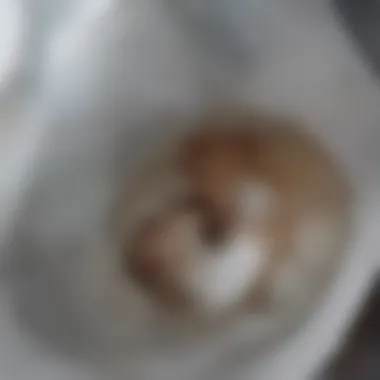Resolving Persistent Toilet Clogs: A Comprehensive Guide


Intro
Navigating the troubles of a persistently clogged toilet is a daunting task for homeowners and property managers alike. A clogged toilet is not simply an inconvenience; it can lead to a range of complications if not managed properly. Understanding the underlying reasons for clogs and knowing how to address them is critical. In this article, we will delve into the common causes of persistent clogs, the diagnostic methods available, and various solutions to enhance toilet functionality. The following sections will offer insight into effective unclogging techniques and preventative measures, ultimately helping you restore normalcy to your bathroom experience.
Prologue to Persistent Toilet Clogging
Toilets are essential fixtures in any home or public restroom. A clogging issue can quickly escalate from a minor inconvenience to a significant problem, disrupting daily activities. Understanding persistent toilet clogging is crucial for homeowners, especially those who seek to avoid costly repairs and maintain a comfortable living environment.
Persistent clogs can stem from various causes, from user habits to underlying plumbing issues. Recognizing these causes can empower individuals to take proactive measures. By exploring the mechanics of toilets and debunking common myths surrounding clogs, this article aims to establish a foundational understanding.
Understanding Toilet Mechanics
To grasp why toilets become persistently clogged, one must first understand their basic design and function. Toilets utilize a simple mechanism: a tank fills with water, which is then released during a flush, moving waste along the plumbing system. The siphoning action created during this process is critical. A toilet requires an adequate amount of water to create this action effectively; otherwise, blockages can occur.
Several factors can influence this mechanism. For example, old toilets may not have the same flushing power as modern ones. Additionally, the size and shape of the pipes can also play a role. If a toilet is used improperly, such as flushing non-biodegradable items, clogs can happen more frequently. Thus, knowing how toilets work helps identify why clogs persist.
Common Misconceptions About Clogs
Many misunderstandings exist about what leads to toilet clogs. One prevalent myth is that all clogs are due to foreign objects being flushed. While this contributes significantly, there are other factors.
- Dietary Products: Excessive use of toilet paper or products like wipes can lead to obstructions.
- Toilet Age: Older toilets may struggle to clear waste properly. This can lead to recurrent issues that are unrelated to the user’s habits.
- Pipe Condition: Wear or tree root invasions can cause unseen blockages unrelated to the toilet's performance.
These misconceptions can lead to ineffective solutions. For instance, merely using more aggressive plunging techniques may not address the underlying issue.
"Understanding what really causes toilet clogs is essential to manage and prevent them effectively."
By demystifying these issues and focusing on the mechanics of the toilet, homeowners can take steps to mitigate persistent clogging problems effectively. This foundation leads to improved strategies for troubleshooting and maintenance.
Identifying the Root Cause
Understanding the root cause of a persistently clogged toilet is crucial for effective resolution. Blockages can result from a range of factors, and identifying the primary issue allows for targeted interventions. Moreover, knowing the source of these clogs can help homeowners make informed decisions to prevent reoccurrences.
Typical Blockages
Toilets can become clogged due to various typical blockages. Many people may think that clogs are simply caused by too much toilet paper or foreign objects going down the bowl. However, several other issues can contribute to these persistent problems:
- Excessive Toilet Paper Usage: Using large amounts can overwhelm the flushing system. This is especially prevalent with low-flow toilets.
- Feminine Hygiene Products: Items that are not meant to be flushed often contribute to major clogs. They do not break down like toilet paper.
- Wipes and Similar Products: Many products claim to be flushable but can cause significant problems in pipes.
- Foreign Objects: Toys or household items accidentally dropped in the toilet can block pipes.
Identifying these typical blockages through observation is a vital first step for any homeowner dealing with a toilet clog.
Role of Toilet Design
Toilet design plays an essential role in clogging issues. Modern toilets vary significantly in their flushing mechanisms and configurations. Important factors include:
- Bowl Shape: Elongated bowls may flush differently compared to round ones, affecting the efficiency of waste disposal.
- Flushing Mechanism: Some toilets use gravity, while others employ a pressure-assisted system. Understanding how your toilet flushes can help in knowing its limitations.
- Trapway Size: Most toilets have piping in the bowl called the trapway. Narrow trapways can inhibit waste flushing and lead to clogs.
Recognizing these design factors can aid users in understanding potential weak points in the toilet, informing future use and maintenance.
Impact of Plumbing Systems
The plumbing system directly affects toilet performance and can lead to persistent clogs if not properly maintained. Several elements are critical:


- Pipe Diameter: Narrow pipes can restrict flow, leading to increased chances of blockage.
- Ventilation: Proper ventilation is essential for waste removal. Poor venting can cause slow draining and recurring clogs.
- Age of Pipes: Older plumbing systems may accumulate debris or develop corrosion, contributing to issues with clogs over time.
Understanding the interplay between plumbing systems and toilet function enables homeowners to address potential plumbing issues proactively.
"Identifying the root cause of clogs is half the battle. A strategic approach can save time and prevent long-term damage."
Initial Troubleshooting Steps
In the face of a persistently clogged toilet, initial troubleshooting steps serve as the crucial first line of defense. Understanding how to approach the problem immediately can save time, reduce frustration, and potentially avoid more severe issues. Part of the strategy includes being aware of the steps that can be taken before assuming there is a more complex underlying issue. Starting with these steps can often lead to a successful resolution without needing professional assistance.
Visual Inspection Techniques
Visual inspection of the toilet is a vital step in the troubleshooting process. It allows homeowners to identify obvious signs of blockage or malfunction that may not require specialized tools to remedy. This includes checking for signs of overflow, foreign objects within the bowl, or issues with the flush handle.
First, examine the water level in the toilet bowl. If the water appears too high, it suggests a blockage just past the bowl. Conversely, if the water level is low, it may indicate a more significant problem in the drainage system.
Other important areas to inspect include:
- The toilet tank: Check for any stuck parts or broken mechanisms that could hinder the flushing process.
- The base of the toilet: Look for any leaks which could indicate problems within the plumbing.
"A thorough visual inspection can often reveal issues that can be easily addressed before more invasive methods are employed."
Taking time for this inspection can provide immediate clues about potential problems.
Using a Plunger Effectively
The plunger is perhaps the most well-known tool for tackling clogs. However, its effectiveness hinges on proper technique. Not every plunge is created equal, so understanding how to use a plunger properly maximizes its efficiency.
When using a plunger, make sure to choose the right type. For toilets, a flange plunger works best due to its design that fits the toilet’s shape. Here is how to proceed:
- Ensure the toilet bowl is filled with adequate water. If it’s too low, add enough to cover the plunger.
- Position the plunger to completely cover the drain hole at the bottom of the toilet bowl.
- Push down firmly, then pull up sharply. This motion creates the pressure needed to dislodge the obstruction.
- Repeat for several cycles before checking for progress.
Patience is key. If the clog doesn’t resolve quickly, other methods may be necessary.
The Toilet Auger Methodology
If the plunger fails to resolve the clog, the toilet auger is another effective tool for homeowners. Unlike a plunger, an auger is designed to reach deeper into the toilet's plumbing. It consists of a long cable with a coiled end, intended to break through or retrieve blockages.
Here are the steps to use a toilet auger:
- Insert the auger into the toilet bowl until you feel resistance.
- Turn the handle to extend the auger deeper into the drain. This should break up or navigate around the blockage.
- Once you feel the resistance dissipate, begin to retract the auger slowly.
- Test the toilet to see if the flow has improved.
The effectiveness of an auger makes it a valuable asset for anyone dealing with frequent clogs.
Chemical Solutions and Their Implications
Chemical solutions play a crucial role in tackling persistent toilet clogs. Often, homeowners turn to these options for their convenience and effectiveness. However, understanding the implications of using chemical-based products is equally important. This section will discuss the various types of drain cleaners, their benefits, and considerations to keep in mind when using them.
Evaluating Drain Cleaners
When selecting a drain cleaner, it is essential to evaluate the specific product's formulation. Different cleaners target various types of blockages, from grease build-up to organic material. Most common types include:


- Caustic cleaners: These contain strong alkalis like sodium hydroxide, which can effectively dissolve organic matter. They can be highly effective but may damage pipes if used excessively.
- Acidic cleaners: Often based on sulfuric acid, these cleaners can break down clogs rapidly. However, they pose significant risks such as corrosion to pipes and safety hazards to users if not handled properly.
- Enzymatic cleaners: These use natural enzymes to break down waste. They tend to be safer for plumbing systems and the environment, although they may require more time to show results.
When considering a drain cleaner, also assess the label for safety instructions and effectiveness claims. Understanding the type of clog you face will aid in selecting the most appropriate cleaner, minimizing the risk of damage to plumbing systems.
Environmental Considerations
The environmental impact of chemical drain cleaners cannot be overlooked. Many common cleaners contain harsh chemicals that can harm aquatic life and contaminate water sources. Therefore, it is imperative to consider eco-friendly alternatives if possible. Enzymatic and biological cleaners, for instance, offer
less harmful ways to manage clogs without impacting the environment adversely.
It is also worth remembering that improper disposal of chemical cleaners can lead to severe environmental consequences. Pouring leftover cleaners down the sink can contribute to pollution. Instead, look for local hazardous waste disposal systems to safely dispose of these products.
"While chemical solutions can be effective for unclogging toilet issues, their environmental and safety implications necessitate thoughtful consideration."
Approaching clog issues with an informed perspective will not only aid in effective resolution but also promote sustainable practices.
Advanced Techniques to Unclog Toilets
Toilet clogs can present serious plumbing challenges, especially when standard methods fail to resolve the issue. Understanding advanced techniques for unclogging toilets is essential for maintaining functionality and preventing damage to plumbing systems. These methods not only provide effective solutions but can also minimize future plumbing problems. This section outlines two significant approaches: hydro jetting and the option of professional plumbing services.
Hydro Jetting as an Option
Hydro jetting is an advanced technique that utilizes high-pressure water to clear stubborn clogs. This method is particularly effective for tough blockages caused by mineral buildup, tree roots, or grease. The process involves inserting a specialized nozzle into the toilet’s drain line, where high-pressure water blasts away debris.
- Efficiency: Hydro jetting can clear blockages that other techniques cannot. It cleans the entire diameter of the pipe, ensuring that all residues are removed.
- Safety: Unlike chemical cleaners, hydro jetting does not introduce harmful substances into the plumbing system. It is a safe method for the environment and your pipes.
- Long-term solution: This technique not only addresses the immediate clog but also helps to prevent future blockages by thoroughly cleaning the pipes.
However, there are considerations to keep in mind:
- Cost: Hydro jetting can be more expensive than traditional methods. Homeowners should weigh the cost against the potential risks of not addressing the clog properly.
- Pipe condition: Older pipes may not withstand the high pressure used in hydro jetting. Before proceeding, it is advisable to have the pipes assessed by a professional.
Professional Plumbing Services
In some cases, persistent clogs require the expertise of a professional plumber. Professional plumbing services bring knowledge and tools that can effectively manage complex scenarios.
- Diagnosis: A professional can accurately diagnose the root cause of the issue. They often use advanced technology, such as video cameras, to inspect the plumbing system.
- Expertise: Plumbers have extensive training in various clog removal techniques. Their experience means they can apply the right method for the specific problem at hand.
- Comprehensive solutions: Professionals can provide a long-term resolution by identifying underlying issues, such as faulty plumbing design or sewer line problems.
When selecting a plumber, homeowners should consider:
- Reputation: Seek out reviews and testimonials to find a reputable service provider.
- Licensing and insurance: Ensure that the plumber is licensed and insured. This protects the homeowner in case of damages or accidents.
Engaging a professional not only resolves the immediate issue but also ensures that the plumbing system operates efficiently for years.
By understanding the advanced techniques such as hydro jetting and professional plumbing services, homeowners can make more informed decisions. These strategies help in overcoming persistent toilet clogs and maintaining system efficacy. They allow for the quick resolution of issues, ensuring that comfort and functionality are restored in the home.
Preventative Measures to Avoid Future Clogs
Preventing toilet clogs is essential for ensuring smooth operation and avoiding expensive repairs. By taking proactive steps, homeowners can significantly reduce the likelihood of encountering persistent issues. The rationale behind preventative measures lies in understanding how certain habits and practices can influence toilet functionality. Mindful use and routine checks not only maintain optimal performance but also save time, money, and frustration in the long run.
Proper Use Guidelines
Adhering to proper use guidelines is critical in preventing toilet clogs. Common mistakes often lead to blockages, so being aware of what should and should not be flushed is essential. Here are key points to consider:


- Limit Flushing Non-Biodegradable Items: Items such as wipes, feminine hygiene products, and paper towels do not break down like toilet paper, leading to clogs.
- Use Minimal Toilet Paper: Too much toilet paper can quickly overwhelm the plumbing. Consider flushing more often or using less paper per visit.
- Educate Family Members: Ensure everyone in the household understands what is safe to flush. This will help to maintain a clog-free environment.
- Avoid Overloading the Toilet: Do not attempt to flush large quantities of waste at once. This practice may strain the plumbing.
Routine Maintenance Practices
Routine maintenance practices are vital for the longevity of your toilet and its plumbing. Incorporating a regular schedule for inspections and cleaning can help identify issues before they escalate. Here are some practices to integrate into your home maintenance routine:
- Regular Inspections: Check for leaks, cracks, or other signs of wear in the toilet and its components. A simple visual inspection can catch problems early.
- Clean the Toilet Regularly: Cleaning the toilet with a gentle cleaner helps to avoid bowl stains and keeps the inner workings clear. Do not use harsh chemicals that can degrade plumbing parts.
- Inspect the Flush Mechanism: Ensure the flapper, chain, and handle are functioning properly. An unresponsive flush can lead to misuse and potential clogs.
- Schedule Professional Inspections: Every few months, consider having a plumber check your plumbing system. They can identify deeper issues that most homeowners might miss.
By adhering to proper use guidelines and routine maintenance practices, clogs can often be prevented before they even start. A simple commitment to these measures will result in more efficient toilet performance and less hassle.
Employing these strategies will go a long way in avoiding the challenges associated with persistent toilet clogs. A mix of careful use and attentive maintenance fosters a reliable toilet experience.
Understanding When to Seek Professional Help
In the realm of home maintenance, a clogged toilet can evoke a sense of urgency. However, knowing the right moment to shift from DIY methods to professional intervention is crucial. This section discusses when it is appropriate to seek help, ensuring that homeowners make informed decisions that protect their plumbing systems and avoid escalating problems.
Persistent clogs might seem like a simple nuisance at first, but they can signify deeper issues within your plumbing infrastructure. Therefore, understanding the signs of complex problems is essential. Additionally, knowing how to choose a reputable plumber can save you time, money, and stress.
Signs Indicating Complex Issues
Identifying the telltale signs of a more severe plumbing issue is imperative. Here are some indicators that suggest it might be time to call in the professionals:
- Repeated Blockages: If your toilet continues to clog after multiple attempts to clear it, the problem could be rooted deeper in the plumbing system.
- Multiple Fixtures Affected: When other fixtures, such as sinks or bathtubs, begin to back up or drain slowly, it may indicate a more significant issue within the main sewer line.
- Foul Odors: Persistent unpleasant smells around the toilet or drains suggest that there may be a blockage or waste buildup in the pipes.
- Unusual Sounds: Gurgling noises when the toilet flushes or drains can point to air trapped in the plumbing, hinting at more serious underlying problems.
- Water Levels Fluctuating: If the water in the bowl rises or falls unexpectedly, this may result from clogs further along in the system.
These signs collectively suggest that the problem before you may be untenable for a DIY approach. Instead, professional assessment ensures that the issue is diagnosed accurately and resolved effectively.
Choosing a Reputable Plumber
Selecting the right expert for your plumbing needs is as important as recognizing the signals of a problem. Here are steps to aid in finding a trustworthy plumber:
- Research and Reviews: Start by reading online reviews on platforms like Reddit or local service websites. Customer feedback is valuable for understanding a plumber’s service quality.
- Certifications and Licenses: Ensure the plumber is certified and licensed to operate in your area. This guarantees compliance with local regulations and standards.
- Get Estimates: Contact multiple plumbers to obtain quotes. This approach allows you to compare prices and services before making a choice.
- Ask for References: A reputable plumber should be willing to provide references from previous clients. Having confidence in their work history is essential.
- Check Insurance Coverage: Verify that the plumber has liability insurance to cover any potential damages during the repair work.
Taking these steps can assure you that the plumber you select will address your needs professionally.
Epilogue: Maintaining Toilet Efficacy
In the realm of home maintenance, the significance of maintaining toilet efficacy cannot be overstated. A functioning toilet is a cornerstone of modern living, contributing not only to comfort but also to sanitation. This article has explored the complexities of persistent toilet clogs, providing insights into causes, solution methodologies, and preventative measures. Understanding these facets is essential for homeowners and property managers alike, as it helps mitigate the frustration and inconvenience associated with unresolved toilet issues.
Summary of Key Insights
Several key points emerge from this discussion. Toilet mechanics play a critical role in clogs. Users must be aware of the design of their toilet and the plumbing system it connects to. Recognizing typical blockages, whether caused by foreign objects or mineral buildup, allows for better identification of the problem's root.
Effective troubleshooting methods, such as visual inspection and proper use of tools like plungers and toilet augers, can resolve many issues without professional intervention. However, chemical solutions should be approached with caution. Some drain cleaners can cause more harm than good, both to the plumbing system and the environment.
Moreover, implementing routine maintenance practices can significantly reduce the likelihood of future clogs. Keeping drains clear and avoiding the disposal of inappropriate materials down the toilet are simple yet effective strategies.
"A well-maintained toilet is not just about functionality but also a reflection of good home management."
Long-term Solutions for Homeowners
For homeowners looking for long-term solutions, several recommendations can be implemented. First, invest in quality plumbing fixtures. Choosing toilets that are designed with effective flushing mechanisms can minimize blockage potential. Low-flow toilets, for instance, can be effective but must be used correctly to avoid inadequate flushing.
Second, establish a routine check-up schedule for plumbing systems. Engaging a professional plumber periodically can preemptively address potential issues. This becomes particularly relevant in older homes, where the plumbing may be outdated or susceptible to clogs.
Finally, education is vital. Homeowners should understand what can and cannot be flushed to ensure their toilets operate efficiently. This knowledge not only preserves the toilet’s functionality but also extends the lifespan of plumbing fixtures, contributing to overall home maintenance.
By focusing on these long-term solutions, homeowners can navigate the challenges of toilet clogs more effectively, ensuring a smoother, more functional home environment.







